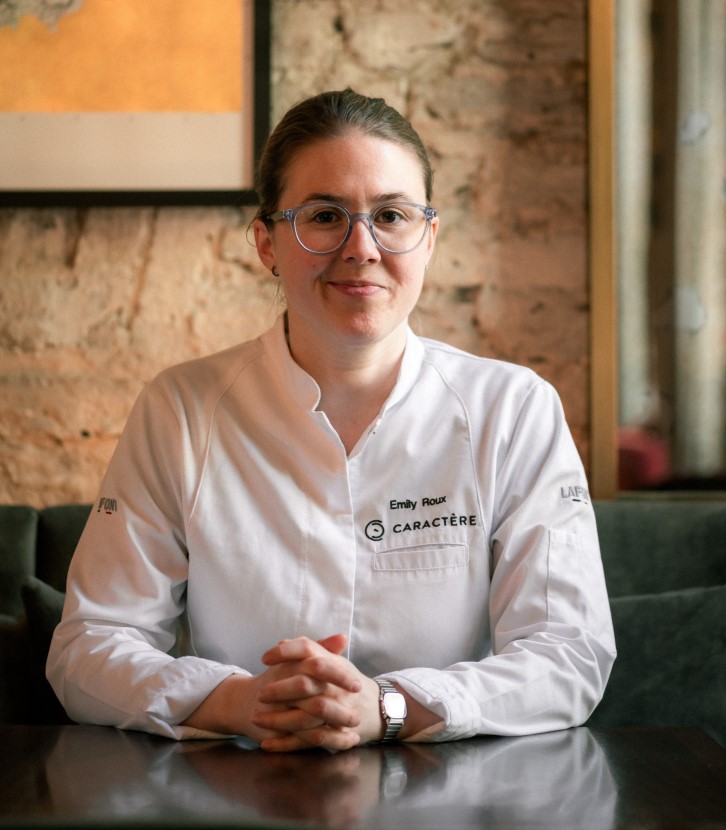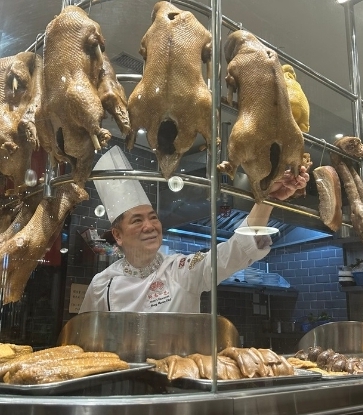Speak to any colleagues about chef Eric Räty, and the first thing they will tell you is that he is a hard worker. Take two-MICHELIN-star restaurant Arbor's owner Michelle Ma-Chan, for instance, who is full of nothing but praise for the young Finnish chef.
"We first met in 2017 when he came to apply for the position of chef de cuisine at Arbor," she recalls. "My first impression of Räty was that he was young and shy, yet resilient, and that he had a strong foundation in French cuisine. After working together with him, however, that's when I saw the hardworking side really come out.”
Ever since he joined Arbor, Räty has been going full steam ahead in experimenting with new dishes every week for her to try, Ma-Chan cites. Whenever he travels, he also enriches his knowledge by trying the local food and incorporating its elements into his work at the restaurant. According to Ma-Chan, Räty's menu keeps getting better. “You can tell that he always expects more from himself,” she says.
Carmen Ko, brand manager of Arbor, works closely with Räty and attests to his continuous drive for learning. “What’s there for me to do?” is a line she often hears from him, and it is this driving force which pushes him to frequently take part in dining events to improve his craft. Over the past year, he has travelled to Macau to become one of the participating chefs at the MICHELIN Guide Hong Kong Macau 2019 International Chef Showcase; to Guangzhou to star as a guest chef at the MICHELIN Guide Guangzhou 2019 gala dinner; and to Taipei to cook at private events. He recently collaborated on a four-hand dinner with Yusuke Takada, chef de cuisine at La Cime, a two-MICHELIN-star restaurant in Osaka; and flew to Prague to participate in a culinary forum.
Räty recently joined his wife Can at Test Kitchen, where they run a weekend pop-up making and selling Finnish pastries — leaving us to wonder if he has more hours than any of us in a day.
But Räty didn't only work this hard after joining Arbor. Räty, now 31, first entered the kitchen at the age of 15 to wash dishes at Chez Dominique, the only two-MICHELIN-star restaurant in Finland at the time. To give himself more exposure to cooking, he planned his tasks well in order to seize opportunities to help the chefs with their preparations, such as slicing onions or rinsing mushrooms. His uncomplicated, hands-on approach combined with his innate interest in cooking impressed head chef Hans Välimäki so much, he made Räty part of his team of chefs. From there, it took Räty only four years to showcase his talent and work his way up from commis chef to chef de partie.
He went on to add a few more appointments to his resume: after a stint as the pastry chef of Aqua, a three-MICHELIN-star restaurant in Germany, he returned to Chez Dominique as head chef, and founded the pop-up restaurant Sandlådan before coming to Hong Kong in 2014 to work under tutelage of the late chef Gray Kunz at Café Gray Deluxe. It wasn't until 2018 that Arbor opened and Räty joined the restaurant as its chef de cuisine. Through a solid foundation in cooking and a lot of hard work, he led the restaurant to attain one MICHELIN star within its first year of operation, followed by two MICHELIN stars in its second year.
In 16 years, Räty has transformed himself from dishwasher to chef de cuisine at one of only 400 two-MICHELIN-star restaurants in the world. His is a story that hard work — slowly but surely — does pay off.

How did you become a dishwasher at Chez Dominique, a two-MICHELIN-star restaurant in Finland?
As a child, I used to cook with my mother and grandmother, and probably took an interest in food during a home economics class. In my home country of Finland, we had to learn how to cook, do laundry, hunt etc. in home economics classes, and one piece of homework at that time was to create a dish. I felt very motivated to do that and this was how I knew I had a keen interest in cooking.
I later enrolled at the Perho Culinary School in Helsinki and worked part-time at a pizzeria. I had never been exposed to fine dining and had no concept of it, until one day, I read a book by Hans Välimäki, chef de cuisine at Chez Dominique: in it, I saw many different photos and read stories about the kitchen, everything was beyond my imagination and I yearned to experience it. So as soon as I saw an ad for a dishwasher role at Chez Dominique on the wall at school, I immediately knew that I wanted to be a part of the restaurant — even if I was only there to wash dishes.
How was it like to be a dishwasher?
It was amazing! On my first day at work, I saw how everyone in the kitchen had focus, speed, yet somehow maintained order despite the chaos. At that moment, I knew I had so much to learn. Chez Dominique was the best restaurant in Finland and the only two-MICHELIN-star restaurant then, so it felt very exciting to be working there, even if I was only washing dishes!
Every day, I planned my tasks and carried them out diligently, then jumped at the chance to help the chef grate onions, wash mushrooms, and perform other prep work. Slowly, I became a part of the team of chefs and worked there for four years.
After leaving Chez Dominique, you went to work as a pastry chef at Aqua, a three-MICHELIN-star restaurant in Germany. Why did you switch from a savoury kitchen to a sweet kitchen?
There’s actually nothing unusual about that because the kitchen at Chez Dominique was tiny and everyone had to help each other out. There’s relatively little distinction between savoury and sweet kitchens at Finnish restaurants, so I already had experience with pastries. I worked in Germany for three years and at that time, I felt it was a good change because I could focus on fine-tuning my techniques in pastry making. I later returned to work at Chez Dominique before coming to Hong Kong in 2014 to join Café Gray Deluxe.

But does being adept at both savoury and sweet kitchens give you an advantage in Asia?
You could say that. In Asia, it does seem as if you pick a direction and focus on it. I'm glad I have experience in both the savoury and sweet aspects, because it gives me more possibilities in my creations!
Why did you choose to move to Hong Kong?
During my stint at Aqua, the restaurant was invited to an event at Tosca Restaurant at The Ritz-Carlton, Hong Kong, which was where I met my wife, Can. She was based in Hong Kong, which made it the best reason to move here.
Tell us about your first impression of Hong Kong.
My first time in Hong Kong was to attend the Tosca event. It was also my first time in Asia. As soon as I left the airport, I was taken to the restaurant that was located so high up, it seemed to disappear into the sky. I thought to myself, “What's going on!” After that, I went to Mongkok for street food and really felt the pulse of the city.
What goals did you set for yourself after moving to Hong Kong?
Of course, the first thing I had to do was to survive. There is a lot of competition in the Hong Kong gastronomy scene, and many people come and go. I hope to bring something new to Hong Kong and that one day, people will know where I’m from.
READ ALSO: The 5 Mother Sauces of French Cuisine

What made you want to apply to Arbor when it was hiring chefs in 2017?
I had been working in hotels for four years at that time and felt like I had to make a choice: stick with hotels, open more restaurants for the same group, or return to fine dining. I was missing the days of fine dining — that level of attention to detail and quality — so I decided to apply.
Did you know that you were the only chef who was interviewed?
What? No way, that’s news to me!
Michelle Ma-Chan, the owner, said the restaurant had originally planned to hire a chef de cuisine for day-to-day operations, as well as another one who specialises in Japanese-French cuisine to act as a consultant. But after tasting your food, not only did they not feel the need to interview other applicants, they decided they didn’t need a consultant anymore.
Really? I didn't ask, so I don't know. But I've always felt fortunate to have known that I was on the right track as soon as I joined. And after meeting chef Nicolas (one-MICHELIN-star ÉPURE executive chef Nicolas Boutin, who had interviewed Räty as both restaurants are part of the Gourmet Dining Group) and Michelle, I was even more certain that I was with the right team and that this would be a great opportunity.
How was the direction of Arbor set?
I joined three months before the restaurant opened, while it was still undergoing renovations, but its style and name had been decided. Its culinary direction had also been set, which was to make French cuisine with Japanese ingredients. Even though I wasn't involved in the decision-making process, I was lucky that everything was a good fit for my background. I also loved the name Arbor, which is Latin for "wood”, since I'm from the forest.
READ ALSO: Chef Spotlight: Nicolas Boutin of Épure

What do you appreciate most about Japan?
I’d say it’s their respect for things, like how a chef would respect food producers, while guests and chefs respect each other too. I also appreciate how they are willing to invest the time to do something really well — a virtue that has been forgotten in many places.
In your dishes, you employ the use of locally grown edible flowers and herbs too. What made you decide to do that?
This is just a tiny step. In Hong Kong, many ingredients are imported, and many people do not give locally grown ingredients the respect they deserve. As chefs, I feel we need to support these local food producers. Not only do they make my dishes better, my feedback helps them improve too. This way, everyone can keep improving together.
How do you conceptualise new dishes?
There are no hard and fast rules. Sometimes, a concept takes a long time to take shape, but there are also times when I see an ingredient and come up with a new dish that same day.
Can you talk about the inspiration behind your signature dish “Langoustine, Japanese Fruit Tomatoes, Kombu, Tomato Juice Sauce"?
This was the first dish we created in Arbor, starting with Japanese fruit tomatoes and candied kombu. We then added different types of kombu to the dish before trying to add Icelandic lobster. The dish was tweaked many times before we came up with the very first version of it. I really like this dish because it's simple, yet rich in flavour and with a refreshing acidity. Since its launch, we have been fine-tuning this dish by adding and subtracting details. There have been so many versions that if you were to ask me which one I’m currently in, I’m afraid I won’t be able to answer your question!
Your "Soy Milk Ice Cream, Crispy Bean Curd Skin, Salted Duck Egg Yolk, Black Bean" dessert was also very popular, yet you had taken it off the menu until customers requested for you to bring it back. Instead, you redesigned the dessert as part of a petit four, so that customers can enjoy it while you introduce other desserts to them at the same time. Could you tell us the story behind the creation of this dessert?
This dish was born in chef Nicolas’ kitchen. Back then, I was practising making desserts in his kitchen while his team was making bean curd skin. I saw these sheets that looked like wood and tasted them, after which I immediately ran to city'super to buy Japanese black beans. Just like that, I had all its elements in my head and we launched this dessert with only a few adjustments.

We’ve heard that you say yes to any invitation you receive, whether it’s for a dinner party, four-hands, and so on, as long as time permits. What’s behind this attitude?
While it's definitely important to focus on the restaurant as a chef de cuisine, you sometimes have to leave some space for other chefs to grow. When you’re cooped up in a restaurant for too long, you also gradually become picky, as if nothing is ever good enough. Go somewhere else from time to time to learn new things, then come back to the restaurant with renewed energy and vigour.
You were only 30 years old when you became the chef de cuisine at Arbor. Is your youth an advantage or a burden to you?
I think it's both. It's kind of crazy when you realise how quickly things have developed, but I’ve never thought to myself “right, my next step is to become a chef de cuisine” — or any other positions. I just wanted to do my job well, take responsibility for my duties, and improve with each day. Somehow, things worked themselves out.
When did you first become aware of the MICHELIN Guide?
When I was working at Chez Dominique, I saw how they pushed themselves to improve, in their pursuit of three MICHELIN stars. I've also waited with them to receive a call from the Guide, with sweaty palms. Later on, during my time with Aqua, I got the sense of how two and three stars differed from one another. To me, that was an indication of the direction from which I was learning.
What was in your mind when Arbor received one MICHELIN star?
It was wonderful, and it felt great to be able to take what I’d learnt from other chefs and apply them towards my current team to lead the restaurant to success.
What about getting two MICHELIN stars?
It's surreal and I need more time to digest it.
Not many people in Hong Kong knew who you were two years ago, but you’re now a hot new star in the gastronomy world. How do you feel about this change?
I haven’t thought too much of it, other than how I can now showcase what we do to more people, and I love that challenge. More eyes will be watching how we perform now, and we must do better.
What makes a good chef?
Many chefs have great skills, but to me, a good one should also be a mentor to others. You have to be able to groom many young chefs to open their own restaurants and get stars. When you have more and more of such apprentices under your wing, then you’re a good chef. Currently, my role models include chef Hans Välimäki and René Redzepi, the Danish chef de cuisine of two-MICHELIN-star noma. I’m moving in that direction, but I still have a long way to go.
This story is written by Mandy Li and translated by Tang Pin-Ji. Click here to read the original article.























